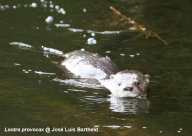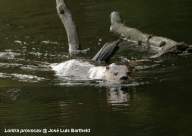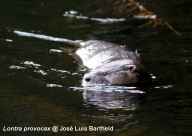 |
Last Update:
Sunday February 22, 2015 |
| •[Home] | [Site Map] | [Contact Us]• | |
| [Home] | [Members] | [News] | [Bulletin] | [Q & A] | [Species] | [Library] |
Lontra provocax (Thomas, 1908), the Southern River Otter (currently being revised)
|
|
DescriptionThis species looks like the North American River Otter, but appears to be smaller. It is highly endangered and rare, and very little is known about it. It is known locally as the Huillin. José Luis Bartheld sent us these lovely pictures of this otter. HabitatThe southern river otter is a freshwater species. Rest and den sites are found in areas with dense vegetation and an abundance of above-ground roots, small rocks or broken stones, which provide suitable crevices from which the animal can view the adjacent water without being exposed. DistributionL. provocax once had an extensive distribution from the Cauquenes and Cachapoal Rivers to the Magellan region in Chile. Now it is restricted to seven isolated areas from Cautín to Futaleufú. Conservation StatusRed List Category Endangered, Decreasing Accelarating habitat destruction and degradation troughout the southern river otter's range is the greatest threat to this species and is estimated to potentially lead to a future > 50% reduction in population size in those populations using rivers and lakes (freshwater habitats). An accelerated growth of fish farming could potentially lead to a future reduction around 50% of population size from those populations using the southern fjords and islands (marine habitats) of Chile over the next 10 years. (Source: IUCN Red List) Current ConcernsPopulations have been confirmed in only seven isolated areas all of which are threatened by a variety of factors including the removal of river bank vegetation, dam construction, river and stream canalization, and dredging which has recently become one of the most serious threats to otter habitat. Furthermore, the large scale of forest destruction in southern Chile may be affecting several of the freshwater habitats through severe flooding and deposition of soil on the river beds. L. provocax is listed in the Chilean Red Data Book of Vertebrates as being in danger of extinction. It is also listed as `Endangered' in the Argentine National Wildlife List. Leading ResearchersMaximiliano Sepúlveda, Claudio Ernesto Chehébar, Gonzalo Medina Vogel, José Luis Bartheld Key PublicationsGeneral
Ecology
Useful Links
|
| [Copyright � 2006 - 2011 IUCN OSG] | [Home] | [Site Map] | [Contact Us] |







